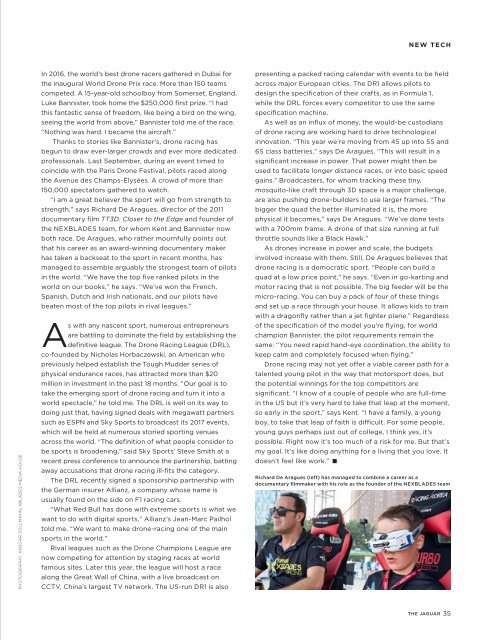Jaguar Magazine 02/2017 – English
Das neue Jaguar Magazin präsentiert den neuen Jaguar E-PACE, blickt hinter die Kulissen der spektakulären Formel E und spricht mit Uhrengenie Jean-Claude Biver darüber, wie es ihm gelingt immer am Puls der Zeit zu bleiben. Lesen Sie rein in die neue Ausgabe THE JAGUAR 02.
Das neue Jaguar Magazin präsentiert den neuen Jaguar E-PACE, blickt hinter die Kulissen der spektakulären Formel E und spricht mit Uhrengenie Jean-Claude Biver darüber, wie es ihm gelingt immer am Puls der Zeit zu bleiben. Lesen Sie rein in die neue Ausgabe THE JAGUAR 02.
Create successful ePaper yourself
Turn your PDF publications into a flip-book with our unique Google optimized e-Paper software.
NEW TECH<br />
PHOTOGRAPHY: ANSGAR SOLLMANN, XBLADES MEDIA HOUSE<br />
In 2016, the world’s best drone racers gathered in Dubai for<br />
the inaugural World Drone Prix race. More than 150 teams<br />
competed. A 15-year-old schoolboy from Somerset, England,<br />
Luke Bannister, took home the $250,000 first prize. “I had<br />
this fantastic sense of freedom, like being a bird on the wing,<br />
seeing the world from above,” Bannister told me of the race.<br />
“Nothing was hard. I became the aircraft.”<br />
Thanks to stories like Bannister’s, drone racing has<br />
begun to draw ever-larger crowds and ever more dedicated<br />
professionals. Last September, during an event timed to<br />
coincide with the Paris Drone Festival, pilots raced along<br />
the Avenue des Champs-Élysées. A crowd of more than<br />
150,000 spectators gathered to watch.<br />
“I am a great believer the sport will go from strength to<br />
strength,” says Richard De Aragues, director of the 2011<br />
documentary film TT3D: Closer to the Edge and founder of<br />
the NEXBLADES team, for whom Kent and Bannister now<br />
both race. De Aragues, who rather mournfully points out<br />
that his career as an award-winning documentary maker<br />
has taken a backseat to the sport in recent months, has<br />
managed to assemble arguably the strongest team of pilots<br />
in the world. “We have the top five ranked pilots in the<br />
world on our books,” he says. “We’ve won the French,<br />
Spanish, Dutch and Irish nationals, and our pilots have<br />
beaten most of the top pilots in rival leagues.”<br />
As with any nascent sport, numerous entrepreneurs<br />
are battling to dominate the field by establishing the<br />
definitive league. The Drone Racing League (DRL),<br />
co-founded by Nicholas Horbaczewski, an American who<br />
previously helped establish the Tough Mudder series of<br />
physical endurance races, has attracted more than $20<br />
million in investment in the past 18 months. “Our goal is to<br />
take the emerging sport of drone racing and turn it into a<br />
world spectacle,” he told me. The DRL is well on its way to<br />
doing just that, having signed deals with megawatt partners<br />
such as ESPN and Sky Sports to broadcast its <strong>2017</strong> events,<br />
which will be held at numerous storied sporting venues<br />
across the world. “The definition of what people consider to<br />
be sports is broadening,” said Sky Sports’ Steve Smith at a<br />
recent press conference to announce the partnership, batting<br />
away accusations that drone racing ill-fits the category.<br />
The DRL recently signed a sponsorship partnership with<br />
the German insurer Allianz, a company whose name is<br />
usually found on the side on F1 racing cars.<br />
“What Red Bull has done with extreme sports is what we<br />
want to do with digital sports,” Allianz’s Jean-Marc Pailhol<br />
told me. “We want to make drone-racing one of the main<br />
sports in the world.”<br />
Rival leagues such as the Drone Champions League are<br />
now competing for attention by staging races at world<br />
famous sites. Later this year, the league will host a race<br />
along the Great Wall of China, with a live broadcast on<br />
CCTV, China’s largest TV network. The US-run DR1 is also<br />
presenting a packed racing calendar with events to be held<br />
across major European cities. The DR1 allows pilots to<br />
design the specification of their crafts, as in Formula 1,<br />
while the DRL forces every competitor to use the same<br />
specification machine.<br />
As well as an influx of money, the would-be custodians<br />
of drone racing are working hard to drive technological<br />
innovation. “This year we’re moving from 4S up into 5S and<br />
6S class batteries,” says De Aragues. “This will result in a<br />
significant increase in power. That power might then be<br />
used to facilitate longer distance races, or into basic speed<br />
gains.” Broadcasters, for whom tracking these tiny,<br />
mosquito-like craft through 3D space is a major challenge,<br />
are also pushing drone-builders to use larger frames. “The<br />
bigger the quad the better illuminated it is, the more<br />
physical it becomes,” says De Aragues. “We’ve done tests<br />
with a 700mm frame. A drone of that size running at full<br />
throttle sounds like a Black Hawk.”<br />
As drones increase in power and scale, the budgets<br />
involved increase with them. Still, De Aragues believes that<br />
drone racing is a democratic sport. “People can build a<br />
quad at a low price point,” he says. “Even in go-karting and<br />
motor racing that is not possible. The big feeder will be the<br />
micro-racing. You can buy a pack of four of these things<br />
and set up a race through your house. It allows kids to train<br />
with a dragonfly rather than a jet fighter plane.” Regardless<br />
of the specification of the model you’re flying, for world<br />
champion Bannister, the pilot requirements remain the<br />
same: “You need rapid hand-eye coordination, the ability to<br />
keep calm and completely focused when flying.”<br />
Drone racing may not yet offer a viable career path for a<br />
talented young pilot in the way that motorsport does, but<br />
the potential winnings for the top competitors are<br />
significant. “I know of a couple of people who are full-time<br />
in the US but it’s very hard to take that leap at the moment,<br />
so early in the sport,” says Kent. “I have a family, a young<br />
boy, to take that leap of faith is difficult. For some people,<br />
young guys perhaps just out of college, I think yes, it’s<br />
possible. Right now it’s too much of a risk for me. But that’s<br />
my goal. It’s like doing anything for a living that you love. It<br />
doesn’t feel like work.”<br />
Richard De Aragues (left) has managed to combine a career as a<br />
documentary filmmaker with his role as the founder of the NEXBLADES team<br />
THE JAGUAR 35


















